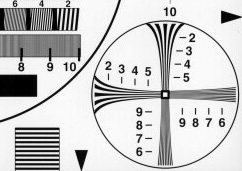Aspiring filmmakers are quite lucky
compared to years ago. Today, you can make a movie in just about any format
and still be taken seriously, assuming that you have a great story and
reasonably good production values. As mentioned,
The Blair Witch
Project is one of the most successful independent features ever
made, yet it was shot with a consumer video camera (non-digital).
Prior to the digital revolution of the
1990s, things were a lot different. If the movie was shot on a format other
than 35mm, it did not stand a chance of being distributed. 16mm was not
taken seriously and video was a joke. These standards were so ingrained in
the industry, that even actors were reluctant to work on non-35mm shoots.
All that has changed now. Affordable,
high-quality digital cameras have democratized the industry. Still, 35mm
film is the standard by which all video formats are judged.
Has video reached the same quality level
as 35mm? Old school filmmakers say "no" because the image capturing ability
of 35mm is a "gazillion" times greater than video. Is this really the case?
Let's take a closer look. The truth may surprise you.
Note: the study below is based on
classic HD with 1080 lines of horizontal resolution. In 2007, the first
ultra HD camera was introduced featuring an amazing 4,520 lines. Keep that
in mind while reading!
Comparison
Their are two factors that can be compared:
color and
resolution. Most casual observers will agree that, assuming a
quality TV monitor, HD color is truly superb. To avoid a longwinded mathematical argument, let's
accept this at face value and focus
on comparing resolution, which is the real spoiler.
Resolution is the visible detail in an image.
Since pixels are the smallest point of information in the digital world,
it would seem that comparing pixel count is a good way to compare
relative resolution.
Film is analog so there are no real "pixels."
However, based on converted measures, a 35mm frame has 3 to 12 million pixels, depending on the
stock, lens, and shooting conditions. An HD frame has 2 million pixels, measured
using 1920 x 1080 scan lines. With this difference, 35mm appears vastly
superior to HD.
This is the argument most film purists use.
The truth is, pixels are not the way to compare resolution. The human
eye cannot see individual pixels beyond a short
distance. What we can see are lines.
Consequently, manufacturers measure the sharpness
of photographic images and components using a parameter called
Modulation Transfer Function (MTF). This process uses
lines (not pixels) as a basis for comparison. Notice the lines in this
resolution chart:

Part of a Standard Resolution Chart
Since MTF is an industry standard, we will
maintain this standard for comparing HD with 35mm film. In other
words, we will make the comparison using lines rather than pixels. Scan
lines are the way video images are compared, so it makes sense from this
viewpoint, as well.
HD Resolution
As discussed previously,
standard
definition and high definition refer to the amount of scan lines in the
video image. Standard definition is 525 horizontal lines for NTSC and
625 lines for PAL.
Technically, anything that breaks the PAL barrier of 625
lines could be called high definition. The most common HD resolutions are 720p and 1080i
lines.
35mm
Resolution
There is an international study
on this issue, called Image Resolution of 35mm Film in
Theatrical Presentation. It was conducted by Hank Mahler (CBS, United States), Vittorio Baroncini (Fondazione
Ugo Bordoni, Italy), and Mattieu Sintas (CST, France).
In the study, MTF measurements
were used to determine the typical resolution of theatrical release
prints and answer prints in normal operation, utilizing existing
state-of-the-art 35mm film, processing, printing, and projection.
The prints were projected in six
movie theaters in various countries, and a panel of experts made the
assessments of the projected images using a well-defined formula.
The results are as follows:
|
35mm RESOLUTION |
|
Measurement |
Lines
|
|
Answer Print MTF |
1400 |
|
Release Print MTF |
1000 |
|
Theater Highest Assessment |
875 |
|
Theater Average Assessment |
750 |
Conclusion
As the study indicates, perceived differences
between HD and 35mm film are quickly disappearing. Notice I use the word "perceived."
This is important because we are not shooting a movie for laboratory
study, but rather for audiences.
At this point, the typical
audience cannot see the difference between HD and 35mm. Even
professionals have a hard time telling them apart. We go through
this
all the time at NYU ("Was this shot on film or video?").
Again, the study was based on
standard HD with 1080 lines of horizontal resolution. We now have
ultra HD with 4,520 lines.
Based on this, the debate is
moot. 16mm, 35mm, DV, and HD are all tools of the
filmmaker. The question is not which format is best, but rather, which
format is best for your project? The answer, of course, is based on a balance
between aesthetic and budgetary considerations.
One of
300 lessons found in Film School Online!
Cinematography Course
Topics
If you are
interested in learning more about the movies used
in this
lesson, click on the title or picture (courtesy 20th Century Fox,
MCA/Universal, Paramount, TCM, and Warner Brothers).
Copyright © Film School Online!
|